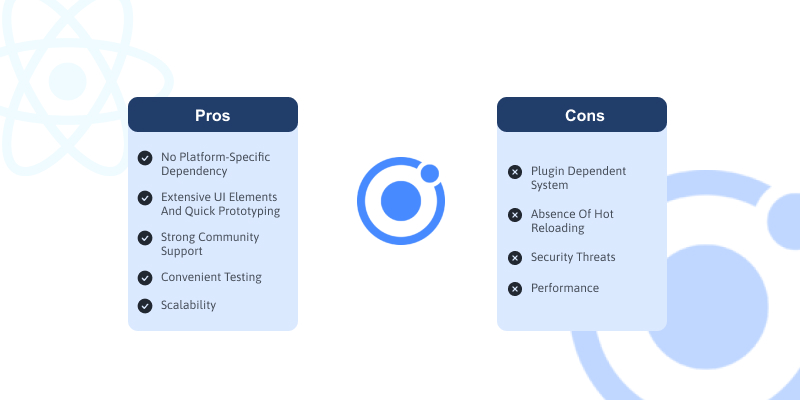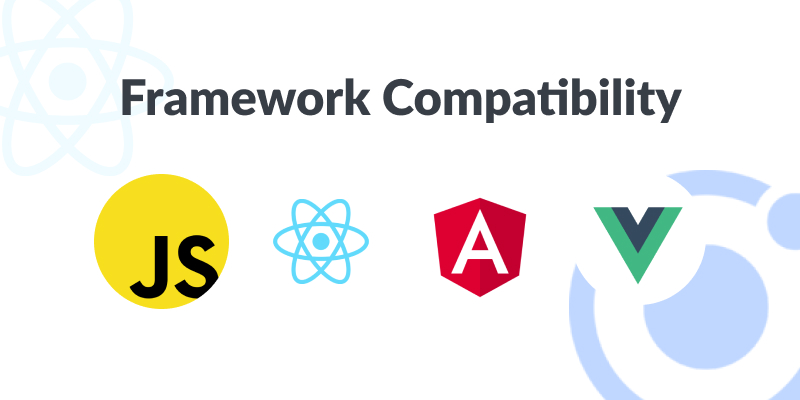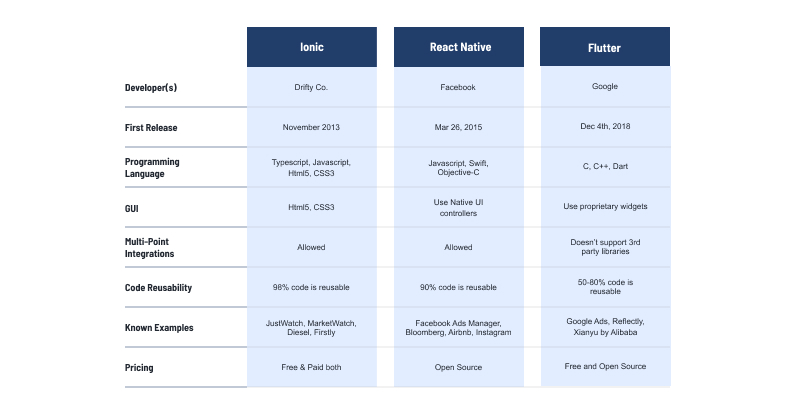With over seven million apps available across iOS and Android platforms, it’s no surprise that most business leaders are delving into a well-strategized cross-platform mobile application development with one of the fastest-growing app development frameworks – Ionic, to stand out from the competition and thrive in the marketplace.
Now, why are tech leaders majorly using Ionic Framework, and how apps with ionic are helping businesses?
Let’s explore this in the blog.
Also, Read – The Best 6 Cross Platform App Development Frameworks
An Introduction to Ionic
With over 5 million Ionic apps built and available in the market, Ionic is a go-to choice for more than 86% of mobile app developers.
If we come down to define, Ionic is a well-integrated, free, open-source UI toolkit utilized for building performant cross-platform apps that work on both mobile and desktop, using web technologies like HTML, CSS, and JavaScript, offering seamless integration with popular frameworks like Angular, React, and Vue at the backend.
Ionic came into existence in 2013 when three coders, Ben Sperry, Adam Bradley, and Max Lynch, built an open-source UI toolkit on AngularJS. Later on 25th July 2019, a stable version of Ionic – a cross-platform app development framework providing efficient performance with minimum DOM manipulation was released.
In essence, Ionic helps improve the frontend user experience of the applications by equipping cross-platform mobile app developers with numerous libraries of mobile-optimized UI components, tools, and gestures that can reciprocate impact and increase impact customer engagement of any enterprise application.
Also, Read – A Quick Guide on Native Vs. Cross-Platform Application Development
Ionic offers comprehensive mobile app development capabilities and spreads them across various platforms. And since every technology has its intricacies, Ionic has it too.

Pros of Ionic Framework –
What distinguishes Ionic from other mobile app development frameworks is its ability to create a single, easy-to-use JavaScript codebase, proffering developers’ freedom to implement the improvement tools without hustle.
Further, here are a few advantages of using Ionic for cross-platform application development:
- No Platform-specific Dependency — One of the primary reasons Ionic is the most preferred cross-platform app development framework is its non-dependency on any platform. And this platform’s independency results in reduced development time and effort.
- Extensive UI Elements and Quick Prototyping — Ionic equips users with ready-to-go components that enable the creation of intuitive and functional apps within no time. The plenty of UI elements, web components, theme base, and typography lead users to focus more on the app’s features rather than on building UI components from time to time.
- Strong Community Support — Another benefit of Ionic is the active community. Built on modern and popular technologies such as Cordova and Angular, Ionic has an immensely advanced and well-versed community to offer support to users while developing cross-platform apps.
- Convenient Testing — When developing a cross-platform app with Ionic, developers can use Cordova commands to efficiently test the Ionic app on a desktop browser and perform simulator testing for iOS and Android apps.
- Scalability — Ionic app development is the most preferred cross-platform app development for numerous reasons, but the scalability opportunity is one of the most significant. Developers leveraging Ionic can seamlessly scale their mobile app and advance the features without worrying about the number of active users and app performance.
Cons of Ionic Framework –
Now that we’ve covered some of the advantages of the Ionic mobile application development framework, now is the time to look at some disadvantages.
- Plugin Dependent System — As read earlier, we know that Ionic offers a plethora of plugins to create intuitive and advanced cross-platform apps. But the drawback of being majorly dependent on plugins is that one only has to use the ready-made package of plugins to implement the required functionality. However, suppose a developer wants to build a native-specific feature for a non-standard piece of hardware. In that case, the user has to develop the plugin independently and transform it into Javascript. This means developers can go entirely web with Ionic, but it becomes a hassle when you want to go native.
- Absence of Hot Reloading — With Ionic app development, one of the most daunting cons is the absence of hot reloading. When a developer adds features or does some change in codes due to the absence of a hot reload, the whole app refreshes and reloads to make changes active, slowing down the development speed.
- Security Threats — When building cross-platform applications, security is a common issue, as long as your app can be reverse engineered. While this isn’t the case with the newer updates of Ionic, using older versions doesn’t support code minification techniques. So, it is undoubtedly a notable point.
- Performance — Developing an app using web technologies like HTML, CSS, and JavaScript and then integrating plugins and libraries means writing a lot of code, making the ionic app reasonably heavier than the native ones. And since Ionic uses web view to render apps, ionic app development is any day, a difficult choice for memory-intensive or complex applications.
Framework Compatibility
With the Ionic 6 beta release, the Ionic Framework has significantly progressed from its underlying AngularJS-only UI library to introducing advanced components and a standalone web component library for building intuitive native web applications compatible with Js Angular, Reach & Vue.

JavaScript
The introduction of web components was intended to remove any hard requirement on a single framework to host the application features. Instead, the Ionic web components enabled the core components to work independently on a web page with just a script tag, thus enabling Ionic to work like a standalone library on a single page, even in a CMS like WordPress.
Angular
It’s no news that Angular is the core of Ionic. While Ionic core components have been built to function as a standalone Web Component library, the @ionic/angular package entails all the functionalities that Angular developers require while developing the applications, thus making the app’s integration with Angular libraries and ecosystem seamless.
React
In addition to JavaScript and Angular, Ionic offers users official support for the popular React library. Ionic React enables React developers to use all the Ionic core capabilities and React to build cross-platform apps that work flawlessly on Android, iOS, web & desktop. With @ionic/react, developers can develop applications that have native-like robustness with intuitive features of Ionic.
Vue
Ionic also offers official Vue 3 library support and lets Vue developers use Ionic components and Vue web capabilities to develop apps that work flawlessly on Android, iOS, web & desktop.
Ionic Support
- Ionic CLI
The official Command Line Interface (Ionic CLI) is a tool that proffers numerous useful commands and quickly scaffolds Ionic apps for Ionic developers. In addition, the Ionic CLI entails an inbuilt development environment, tools, and much more that eases applications’ installation and updating.
However, users who have Appflow can also leverage CLI for cloud build, app deployments, and account administration.
- Appflow
Appflow is Ionic’s commercial service for building, deploying, and managing Ionic apps. Primarily Appflow equips the users with a centralized dashboard wherein app developers can compile native app builds and deploy the builds’ live code as an app update. Ionic’s commercial service – Appflow mandates having an Ionic account with a complimentary “Free Hobby Plan” associated.
Further, users must opt for paid Ionic upgrades and plans for accessing more advanced upgrades like direct publishing, SSO (single sign-on), automated workflow, and service integrations.
- Ionic Developer Ecosystem
One of the best benefits of using Ionic is the active community of international developers and contributors actively developing and maintaining the Ionic ecosystem fueling its growth and adoption. From enterprise teams seeking development support to individual developers looking for guidance, Ionic offers numerous ways to get help from the community.
Ionic Starter Pack
Here’s a quick look at what comes with Ionic as an add-on benefit:
- Documented Guide – Users are equipped with detailed documentation that covers all the intricacies of Ionic app development. The guide entails details of CLI installation, app development commands, platform launches, etc., basically, everything that’s important for someone using Ionic.
- Official Migration Guide – Every app development framework grows in time. Being one of the fastest growing cross-platform app development frameworks, Ionic has grown immensely with the beta release of its version 6. Ionic’s migration guide is another asset for developers as it helps in migrating their existing code base into the latest version of Ionic.
- Stencil Library – The Ionic’s stencil library is a primary web component compiler that lets developers download, compile and build faster, more capable components that function seamlessly across every significant device framework.
- Cordova Plugins Repository – As read earlier, we know that Ionic apps have native functionalities; well, this native functionality is because of the Apache Cordova plugins. The Cordova plugin repository primarily allows an app to leverage the native device capabilities beyond what is available to pure web apps.
- Capacitor Plugins Repository – Ionic’s Capacitor is an open-source repository that bridges the gap between web technologies and native devices’ APIs and features. With Capacitor, app developers can leverage any web technology, be it JavaScript, HTML, or CSS, to develop native mobile apps accessing the native device APIs and features (such as location, accelerometer, camera, notifications, and more), to build native mobile apps from the ground up.
- Integrations Page – Another app development asset for ionic app development is the Ionic’s integrations page. This page helps developers with a compiled list of tools, modules, and native plugins that can be integrated into your application, making it more intuitive and robust.
Cross-platform App Development Frameworks’ Comparision in a Nutshell

Conclusion
When it comes to app development, there are no good or bad tools or technologies; there are just solutions built for specific app development purposes. For instance, when it comes to cross-platform app development, Ionic is an excellent framework with a significant focus on the frontend UX and UI interaction of an app with gestures and animations. It’s an easy-to-work app development framework that allows integrations with leading technologies like Angular, React, or Vue. And can also be used standalone to develop apps without any frontend framework using a simple javascript framework.
Further, suppose you are a business leader looking for cross-platform app development. In that case, you can get in touch with the top cross-platform app development company and start building the most tech-advanced app that reciprocates business growth.




